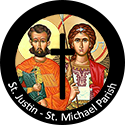The second coming
SECOND SUNDAY OF ADVENT
December 5, 2021
Scripture scholars tells us that the Gospel of Luke was written fifty years or so after Jesus’ death and resurrection. So Luke was not there with parchment and ink when John the Baptism traveled throughout the Jordan calling for a baptism of repentance. But he knew what a pivotal moment that was. So he begins his account by mentioning people like Lysanias and places like Trachonitis, names found nowhere else in the Bible. Why? He is setting the scene in exhaustive detail because of the dramatic difference between before” and “after.” Just as our country memorializes 1776 or parents recall the year in which they had their first child, there is a life-changing difference between what came before and what came after. Just so for this proclamation of John’s. The transformation Baruch prophesied about Jerusalem was now taking place. Luke paints a picture of exactly how the world had been before everything changed. That having been said, each reading ultimately directs our focus onto the future. Baruch looks forward to the time when Jerusalem is restored in glory. Luke, John the Baptist calls everyone to prepare for Jesus’ coming, when salvation will come to all people. Paul looks ahead to “the day of Christ Jesus,” the time of the Second Coming (Philippians 1:6). As Christians, we are called to anticipate the completion of the good work that has begun in us. How are valleys filled in, mountains made low, paths made straight, and rough ways smoothed? Repentance. It is sin that throws up obstacles on our paths to salvation. Like a falling out between friends prevents that friendship from growing, our past sins prevent our Love of God and love of neighbor from developing. Repentance allows us to put aside the past and focus on the future. Amen. (Casey, Most Reverend Robert G. Pastoral Patterns. World Library Publication, 2021).
CHANGE A LIFE TODAY
Remember a friend in prayer today.
